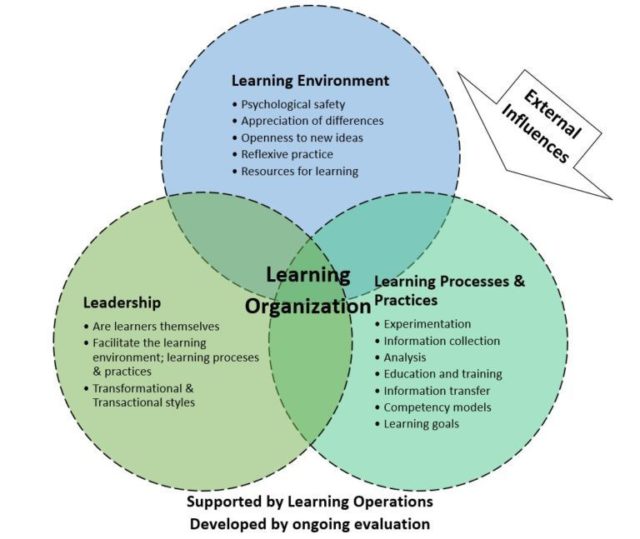Theoretical And Practical Foundations Of A Learning Organization
Research over the past number of decades has shown that organizations looking to remain relevant and competitive in our current context must become learning organizations. But what exactly is a learning organization, and what does it look like?
Peter Senge, author of the Fifth Discipline, popularized the term ‘learning organization’ in the early 90s. He defines learning organizations as “organizations where people continually expand their capacity to create the results they truly desire, where new and expansive patterns of thinking are nurtured, where collective aspiration is set free, and where people are continually learning to see the whole together.”
Essentially, a learning organization fosters learning at all levels with all members, and together as a collective.
Learning organizations describe the ideal context in which to embed learning initiatives, whether mobile, online, or onsite. They become part of how learning is fostered individually and collectively across the organization, and because they are aligned to organizational, team, and individual goals, they are more likely to be effective.
After reviewing the research, I have developed a hybrid learning organization model to illustrate the key aspects of a learning organization: the learning environment, learning processes and practices, and leadership. These three areas overlap as they influence and reinforce one another. They are impacted by external factors such as political, economic, legal, or ecological changes, and are supported by learning operations.

Figure 1. A learning organization model. Adapted from Garvin, Edmondson, and Gino (2008) and Sarder (2016). Additional items include reflexive practice from Lyle (2012), leadership styles from Froehlich, Segers, and Van den Bossche (2014), and external influences from Gaile (2013).
Learning Environment
As mentioned, the learning environment fosters learning at all levels with all members. At the core, this involves psychological safety. People need to feel safe to express their opinions, take risks, examine failure and challenge dominant ideologies. Differences are appreciated, and there is an openness to new ideas because it disrupts inertia and encourages innovation. Learning organizations engage in reflexive practice, learning from the past and applying knowledge to present and future needs. They devote adequate resources to support learning initiatives.
Learning Processes And Practices
Learning processes and practices give tangible expression to the learning environment. Learning organizations are often experimenting to develop new approaches, products, or services. They collect all kinds of information from a variety of sources, both internal and external, analyzing and interpreting it to solve problems and identify trends. They facilitate ways to intentionally share this knowledge among people, both laterally and vertically.
Education or training is provided through informal and formal methods, whether eLearning, mobile learning, classroom, coaching, mentoring, or on the job. Depending on the desired outcome, a combination of methods is used. Competency models define knowledge, skills, and abilities for the organization, its departments, and its jobs. Organizational, team and individual goals for Learning and Development are interconnected and support the competencies. A variety of assessments are employed to evaluate satisfaction, learning, and results. Assessment data is used for continuous improvement, and facilitating alignment between goals, processes, and practices.
Leadership
First and foremost, leaders in a learning organization are learners themselves. They set the example for others and facilitate the learning environment, as well as learning processes and practices.
Research supports the use of transformational and transactional leadership styles in a learning organization. Transformational leaders inspire others and build relationships with followers to develop them. They pay attention to power dynamics, sharing their power and enabling others to think and act more independently. Transactional leaders provide rewards and punishments to help reach goals. Though not mentioned in the model, I have seen many other styles work in a learning organization, such as authentic or servant leadership. These have the added benefit of more explicitly considering a moral framework for leadership. Overall, leaders are essential in helping create and facilitate a learning organization.
Over To You
How have you experienced learning organizations? Do you agree that they help learning initiatives succeed? What else might you add to the model from your research or experience? Add your thoughts in the comments.
If you are looking for more on learning organizations, I recommend Sarder’s book in the references section.
References
- Froehlich, D., Segers, M., & Van den Bossche, P. (2014). Informal workplace learning in Austrian banks: The influence of learning approach, leadership style, and organizational learning culture on managers' learning outcomes. Human Resource Development Quarterly, 25(1), 29-57.
- Gaile, A. (2013). External factors facilitating development of learning organization culture. Journal of Business Management, 7, 130-140.
- Garvin, D. A., Edmondson, A. C., & Gino, F. (2008). Is yours a learning organization? Harvard Business Review, 86(3), 109-116.
- Lyle, E. (2012). Learning organization[al] learning. International Journal of Business and Social Sciences, 3(6), 217-221.
- Sarder, R. (2016). Building an innovative learning organization: A framework to build a smarter workforce, adapt to change, and drive growth. Hoboken, NJ: Wiley.
- Senge, P. M. (1990). The fifth discipline: The art & practice of the learning organization. New York, NY: Doubleday Business.









